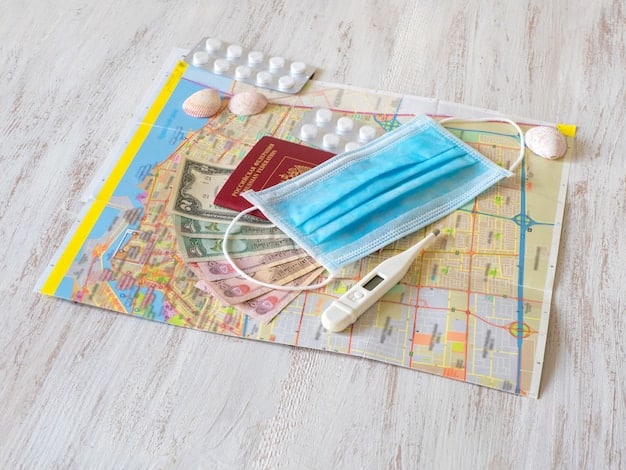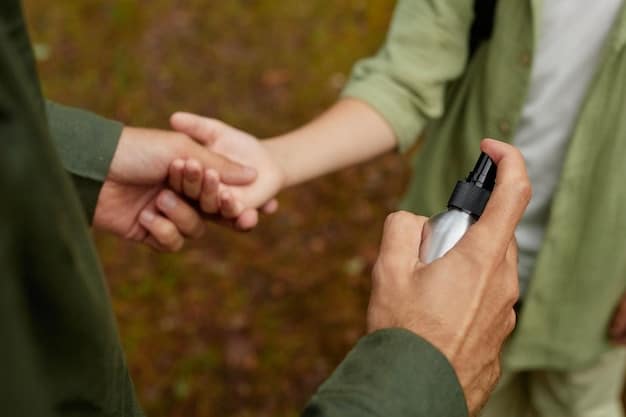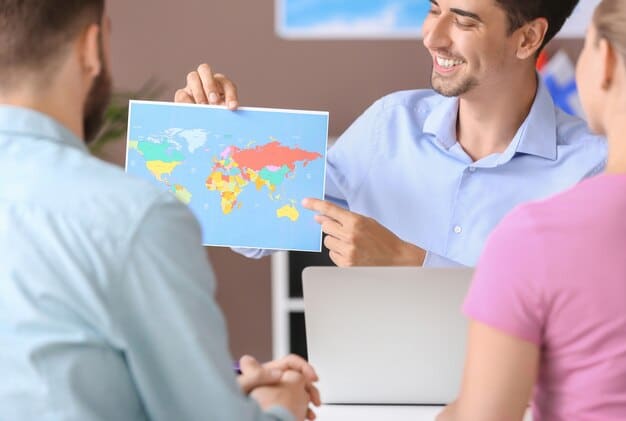First Aid for Travelers: Essential Medical Skills for Emergencies

Navigating unexpected health crises while traveling demands proficiency in first aid for travelers: essential medical skills to handle emergencies on the road, ensuring readiness for unpredictable situations far from home.
Embarking on a journey, whether for leisure or business, often fills us with anticipation for new sights and experiences. Yet, the unforeseen can strike anywhere, making preparedness a traveler’s most valuable asset. Understanding first aid for travelers: essential medical skills to handle emergencies on the road is not merely a good idea; it is a critical investment in your safety and well-being, and potentially that of those around you. This guide offers insights into equipping yourself with the knowledge to manage health challenges that might arise during your adventures.
Understanding the Basics of Travel First Aid
Venturing into unfamiliar territories often brings an element of excitement, but it intrinsically carries unique risks. From minor scrapes to more significant injuries, being away from immediate medical facilities can turn a small issue into a major concern. Travel first aid isn’t about becoming a doctor overnight, but rather about acquiring the fundamental skills to assess situations, provide immediate care, and stabilize conditions until professional medical help is available or accessible.
The core philosophy revolves around two principles: prevention and rapid response. While we aim to prevent incidents, accidents can still happen. In such cases, knowing how to act decisively can significantly impact outcomes, potentially minimizing discomfort, preventing complications, or even saving a life.
Assessing the Situation and Ensuring Safety
Before offering any aid, your personal safety is paramount. A quick assessment of the environment can prevent you from becoming another casualty. This involves looking for immediate dangers, such as unstable ground, traffic, or hostile individuals. Once the scene is deemed safe, you can then focus on the injured individual. This systematic approach—”Danger, Response, Airway, Breathing, Circulation” (DRABC) or a similar protocol—is crucial for effective first aid.
- Assess for Danger: Look for any immediate threats to yourself or the patient.
- Check for Response: Determine if the person is conscious and responsive.
- Open Airway: Ensure the person’s airway is clear.
- Check for Breathing: Observe if the person is breathing normally.
- Check for Circulation: Look for signs of severe bleeding.
Understanding these initial steps provides a structured way to approach an emergency, ensuring crucial physiological functions are addressed first. It’s about prioritizing care based on the immediate threat to life.
Moreover, effective communication, even in a foreign language through gestures or translation apps, is vital. Try to gather information about what happened, any pre-existing medical conditions, allergies, or medications the person is taking. This preliminary information can be invaluable for subsequent medical professionals.
The ability to remain calm under pressure is probably one of the most underrated first aid skills. Panicking can cloud judgment and hinder effective action. Practicing basic first aid scenarios mentally can help train your mind to react more calmly when real-life situations arise. This mental preparedness is as important as the physical supplies in your kit.
In conclusion, mastering the basics of travel first aid begins with a proactive mindset towards safety and a structured approach to initial patient assessment. These foundational skills are the bedrock upon which all other first aid techniques are built, empowering you to respond confidently and effectively when every second counts during your travels.
Building Your Essential Travel First Aid Kit
A well-stocked first aid kit is more than just a collection of medical supplies; it’s a portable sanctuary of preparedness, tailored to the specific demands of travel. The contents should reflect your destination, the duration of your trip, and any personal medical needs. While pre-made kits exist, customizing one ensures you have exactly what you need, nothing more, nothing less. This personalized approach to your medical readiness can make a significant difference in managing unexpected health issues on the go.
Key Components for Every Traveler
Beyond the standard bandages and antiseptic wipes, consider adding items that address common travel ailments. Dehydration, digestive issues, and cuts are frequent occurrences. Therefore, rehydration salts, anti-diarrhea medication, and various sizes of adhesive dressings are fundamental. Pain relievers, allergy medication, and any personal prescription drugs should also be included.
- Wound Care: Assorted bandages, sterile gauze, antiseptic wipes, medical tape, sterile gloves.
- Medications: Pain relievers (e.g., ibuprofen, acetaminophen), allergy medication (antihistamines), anti-diarrhea pills, rehydration salts.
- Personal Prescriptions: Ample supply of any necessary prescription medications, preferably with a copy of the prescription.
- Tools: Small scissors, tweezers, thermometer, safety pins, blister treatment.
Furthermore, thinking about the environment you’ll be in is crucial. Tropical destinations might necessitate insect repellent and sting relief, whereas high-altitude trekking demands supplies for altitude sickness. Sunscreen, lip balm with SPF, and hydrocortisone cream for skin irritations are universally beneficial.
Special Considerations: Destination and Activity Specifics
Your itinerary should heavily influence your kit’s contents. A remote hiking trip calls for more robust items like splint materials and specialized wound closure strips, while an urban excursion might only require essentials for minor injuries. Always carry a small card with emergency contacts and essential medical information, including blood type and allergies. This can be invaluable if you’re unable to communicate.
For parents traveling with children, the kit requires additional considerations. Child-friendly pain relievers, specific dosages for medications, and extra supplies for common childhood ailments are a must. Always double-check expiration dates on all medications and supplies before packing your kit. Rotating stock annually ensures everything is fresh and effective.
The container itself matters. A waterproof, durable bag keeps contents safe and dry in various conditions. Organizing items into smaller, labeled bags within the main kit can save precious time during an emergency. Make sure your kit is easily accessible, not buried at the bottom of a suitcase.
In essence, building your travel first aid kit is an ongoing process of assessment and adaptation. It’s about being proactively prepared for the medical challenges that could arise, allowing you to face your travels with greater confidence and peace of mind. Investing time in assembling a thoughtful kit is an investment in your safety and ability to handle unexpected situations proficiently.
Common Travel Ailments and How to Handle Them
Even the most meticulously planned trips can be waylaid by common travel ailments. Being prepared to address these issues can prevent them from escalating and interrupting your adventure. Understanding the symptoms and immediate steps for conditions like traveler’s diarrhea, dehydration, and cuts is a critical component of first aid for travelers.
Digestive Disturbances: Traveler’s Diarrhea
Traveler’s diarrhea is perhaps the most common health complaint among international travelers. It’s typically caused by consuming contaminated food or water. Symptoms often include abdominal cramps, nausea, vomiting, and frequent loose stools. The primary concern is dehydration, especially in hot climates.
- Rehydration: Drink plenty of fluids, ideally oral rehydration solutions.
- Diet: Stick to bland foods (BRAT diet: bananas, rice, applesauce, toast).
- Medication: Over-the-counter anti-diarrhea medication (e.g., loperamide) can provide symptom relief. Consult a doctor if symptoms persist or worsen.
Prevention is key, which involves practicing careful hygiene, drinking bottled water, and avoiding uncooked foods or unpeeled fruits and vegetables in high-risk areas. Always wash your hands or use hand sanitizer before eating.
Dehydration: A Silent Threat
Dehydration occurs when your body loses more fluids than it takes in. This is particularly prevalent in hot climates, during intense physical activity, or when experiencing diarrhea or vomiting. Symptoms include thirst, dry mouth, fatigue, infrequent urination, and in severe cases, dizziness or confusion. Replenishing fluids and electrolytes promptly is crucial.
Carry a reusable water bottle and fill it frequently from safe sources. Electrolyte tablets or powders are excellent additions to your travel first aid kit. For severe dehydration, seeking medical attention is imperative, as intravenous fluids may be necessary.

Cuts, Scrapes, and Blisters: On-the-Go Wound Care
Minor injuries are almost inevitable when exploring new environments. Cuts, scrapes, and blisters can be uncomfortable and, if not properly managed, can lead to infection. Prompt cleaning and dressing of wounds are essential.
For cuts and scrapes: Clean the wound thoroughly with antiseptic wipes or clean water and soap. Apply an antiseptic cream or spray, then cover with a sterile bandage to prevent infection. Change dressings regularly. For blisters: Avoid popping them if possible. If a blister breaks, clean it gently and cover it with a hydrocolloid bandage to protect it and promote healing. Consider moleskin for areas prone to friction.
Always monitor wounds for signs of infection such as redness, swelling, increased pain, or pus. If these symptoms occur, especially if accompanied by fever, seek medical attention. Having a small, portable first aid kit specifically for these types of minor injuries can save you a lot of discomfort and worry, allowing you to continue your travels with confidence.
By understanding and preparing for these common ailments, travelers can ensure that minor health setbacks do not derail their entire trip. Proactive measures combined with essential first aid knowledge empower you to manage these situations effectively, keeping your adventure on track.
Responding to More Serious Emergencies
While we hope to avoid them, more serious medical emergencies can occur during travel. Knowing how to react in situations like severe bleeding, fractures, or allergic reactions can be life-saving. These skills extend beyond basic first aid and delve into critical immediate response, which is a cornerstone of advanced first aid for travelers.
Managing Severe Bleeding: The Basics of Hemostasis
Severe bleeding, whether from a deep cut or a traumatic injury, requires immediate and decisive action to prevent significant blood loss and shock. The primary goal is to apply direct pressure to the wound to stop the flow of blood until professional medical help arrives.
- Direct Pressure: Apply firm, constant pressure directly onto the wound using a clean cloth or sterile dressing.
- Elevation: If possible, elevate the injured body part above the level of the heart.
- Pressure Points: In extreme cases, apply pressure to an artery supplying blood to the injured limb.
Do not remove any objects impaled in the wound; instead, stabilize them and apply pressure around them. If bleeding is profuse and continuous despite direct pressure, consider using a tourniquet as a last resort, but only if you have been trained in its proper application, as improper use can cause significant tissue damage.
Fractures and Sprains: Immobilization and Support
A fall or impact can lead to fractures (broken bones) or sprains (stretched or torn ligaments). Distinguishing between the two can be challenging without medical equipment, so it’s safer to treat any suspected fracture as such. The key is to immobilize the injured area to prevent further damage and reduce pain.
For a suspected fracture: Immobilize the limb using a splint or by binding it to an uninjured part of the body (e.g., arm to chest, leg to leg). Apply ice packs to reduce swelling and pain, and keep the person still. Seek immediate medical attention. For sprains: The R.I.C.E. method (Rest, Ice, Compression, Elevation) is commonly recommended. Rest the injured part, apply ice, compress with a bandage, and elevate the limb.
Avoid trying to reset a bone or force a limb into a different position. The goal is stabilization and comfort until medical professionals can assess and treat the injury appropriately. Your role is to prevent further harm.
Anaphylaxis: Recognizing and Reacting to Severe Allergic Reactions
Anaphylaxis is a severe, potentially life-threatening allergic reaction. It can be triggered by food, insect stings, medications, or other allergens. Symptoms can be rapid and include difficulty breathing, swelling of the face/throat, hives, dizziness, and a sudden drop in blood pressure. Immediate treatment often involves an epinephrine (adrenaline) auto-injector (EpiPen).
If someone experiences anaphylaxis and has a prescribed EpiPen, help them administer it immediately. Call for emergency medical services without delay. Even if symptoms improve after the injection, professional medical evaluation is crucial as symptoms can recur. Knowing how to identify the signs of anaphylaxis and how to assist someone with their medication is a critical skill for any frequent traveler.
While these situations are daunting, training in advanced first aid techniques can empower you to act confidently and competently. Consider taking a certified first aid and CPR course before your next major trip, as hands-on practice can solidify your knowledge and build your self-assurance in handling potentially life-threatening emergencies.
CPR and Basic Life Support for Travelers
Cardiopulmonary Resuscitation (CPR) and basic life support (BLS) are fundamental skills in emergency care, particularly crucial when professional medical help is not immediately accessible, which is often the case when traveling. These techniques can sustain life until emergency services arrive, making them indispensable components of first aid for travelers.
When and How to Perform CPR
CPR is performed when someone’s breathing or heart has stopped. Recognizing these signs—unresponsiveness, no breathing or only gasping, and no signs of circulation—is the first step. The current guidelines emphasize chest compressions, often referred to as “hands-only CPR” for untrained bystanders, simplifying the process and encouraging more people to act. For those trained, it involves alternating chest compressions with rescue breaths.
- Call for Help: Immediately call emergency services (local equivalent to 911).
- Compressions: Push hard and fast in the center of the chest (about 100-120 compressions per minute).
- Breaths (if trained): After 30 compressions, give 2 rescue breaths (if comfortable and trained).
The rhythm of compressions can be maintained roughly to the beat of “Stayin’ Alive” by the Bee Gees. The goal is to maintain blood flow to the brain and other vital organs, buying critical time. Bystander CPR significantly increases the chances of survival for someone who has suffered cardiac arrest.
Automated External Defibrillators (AEDs)
Many public places, including airports, train stations, and hotels, are now equipped with Automated External Defibrillators (AEDs). These devices are designed to be user-friendly, with voice prompts guiding the rescuer through the steps. An AED can analyze heart rhythms and deliver an electrical shock if necessary to restore a normal heartbeat.
Familiarize yourself with the location of AEDs in busy public areas. If an AED is available during a cardiac arrest, use it immediately after calling for help and starting CPR. The combination of early CPR and defibrillation dramatically improves survival rates. Training courses often include practical sessions on how to use an AED, reinforcing the theoretical knowledge.
Responding to Choking: Heimlich Maneuver
Choking occurs when an object blocks the airway, preventing breathing. It’s often indicated by inability to speak, cough, or breathe, and clutching the throat. The Heimlich maneuver (abdominal thrusts) is the most effective technique for dislodging the obstruction.
For adults: Stand behind the person, wrap your arms around their waist, make a fist with one hand and place it just above their navel, grasp your fist with your other hand, and thrust inward and upward forcefully. Repeat until the object is expelled. For infants: Use back blows and chest thrusts. Immediate action in a choking emergency can save a life and requires no specialized equipment.
While CPR and BLS can seem daunting, comprehensive training provides the confidence and competence needed to act effectively. Consider enrolling in a certified course from organizations like the American Heart Association or Red Cross before your travels. These skills are universal and invaluable, offering a profound sense of preparedness for any unexpected medical crisis.
Navigating Medical Resources Abroad
Even with excellent first aid for travelers skills, there comes a point where professional medical assistance is necessary. Understanding how to access and utilize medical resources abroad, including emergency services, pharmacies, and travel insurance, is as crucial as knowing how to treat an injury. This knowledge ensures continuity of care and can mitigate financial burdens.
Accessing Local Emergency Services
Before you travel, make a note of the local emergency numbers. Just as 911 is universal in the United States, other countries have their own equivalents (e.g., 112 in Europe, 999 in the UK). Knowing this number instantly can save critical time in an emergency. In many tourist areas, English-speaking operators may be available, but this isn’t guaranteed.
When calling for help, provide clear, concise information: your location, the nature of the emergency, and the number of people involved. If possible, have someone meet the ambulance or emergency personnel to guide them to your exact location. Remember that emergency response times and capabilities vary widely by country and region.

Pharmacies and Prescriptions Overseas
Pharmacies abroad can be a valuable resource for minor ailments and refills. However, laws regarding prescription medications vary significantly. Always carry a copy of your prescription, ideally translated into the local language, for any necessary medications. The generic name of the drug, rather than the brand name, is more universally recognized.
Be aware that some medications available over-the-counter in your home country may require a prescription abroad, and vice-versa. Additionally, certain medications (e.g., strong painkillers, specific controlled substances) may be restricted or illegal in some countries. It is advisable to research these regulations before departure. Pharmacies are also excellent places to ask for advice on minor health issues, as pharmacists often have extensive medical knowledge.
The Role of Travel Insurance
Travel insurance is not just a safety net; it’s a vital component of responsible travel planning. A comprehensive policy typically covers emergency medical treatment, hospitalization, medical evacuation, and repatriation. Without it, unexpected medical expenses abroad can quickly lead to substantial debt.
Before purchasing a policy, carefully read the terms and conditions, paying close attention to coverage limits, pre-existing condition clauses, and any activities that might void your coverage (e.g., extreme sports). Understand the process for filing claims and who to contact in an emergency. Many travel insurance providers offer 24/7 assistance hotlines, which can help you navigate local healthcare systems and arrange for medical transport if needed.
Having a clear understanding of these resources empowers you to seek appropriate medical care when your first aid skills are no longer sufficient. This preparedness ensures that while you focus on the adventure, the critical back-end support for your health is firmly in place, allowing for a safer and more confident journey.
Preparing for Specific Travel Scenarios
Travel offers a myriad of experiences, from serene beach holidays to adventurous treks in remote mountains. Each scenario presents distinct health challenges and requires tailored first aid preparations. Being able to adapt your first aid for travelers expertise to specific environments is a mark of a truly prepared adventurer.
High-Altitude Sickness: Prevention and Management
Venturing into high-altitude regions can trigger altitude sickness, a condition caused by reduced oxygen levels. Symptoms can range from mild (headache, nausea, fatigue) to severe (High-Altitude Cerebral Edema – HACE, High-Altitude Pulmonary Edema – HAPE), which can be life-threatening. Gradual acclimatization is the best prevention.
- Ascend Slowly: Allow your body time to adjust by ascending gradually.
- Stay Hydrated: Drink plenty of fluids, but avoid alcohol and excessive caffeine.
- Medication: Acetazolamide (Diamox), prescribed by a doctor, can aid acclimatization.
If symptoms appear, descend to a lower altitude immediately. Ignoring severe symptoms can be fatal. Carry a pulse oximeter to monitor oxygen saturation, which can provide an early warning of problems.
Tropical Destinations: Insect-borne Diseases and Heat-Related Illnesses
Tropical climates introduce risks such as insect-borne diseases (e.g., malaria, dengue fever, Zika virus) and heat-related illnesses (heat exhaustion, heatstroke). Prevention is paramount. Use effective insect repellents, wear protective clothing, and consider taking prophylactic medication for malaria if traveling to endemic areas—consult your doctor well in advance.
For heat-related illnesses: Stay hydrated, seek shade during the hottest parts of the day, and wear loose, light-colored clothing. Recognize the signs of heat exhaustion (heavy sweating, weakness, dizziness, nausea) and heatstroke (hot, dry skin, confusion, loss of consciousness), which is a medical emergency requiring immediate cooling and professional help.
Remote Areas: Self-Sufficiency and Evacuation Plans
Traveling to remote areas significantly increases the importance of self-sufficiency in first aid. Medical facilities may be hours or even days away. Your first aid kit should be more comprehensive, including wound closure strips, splinting materials, and possibly broad-spectrum antibiotics (with a prescription). Learning basic wilderness first aid techniques, such as proper wound irrigation for remote settings, can be invaluable.
Crucially, have an evacuation plan in place. This includes carrying satellite communication devices, knowing emergency contact numbers for local rescue services, and ensuring your travel insurance covers remote rescue and medical evacuation. Share your itinerary with someone reliable, and check in regularly.
By tailoring your first aid preparation to the unique demands of each travel scenario, you enhance your safety and preparedness. This proactive approach not only protects you but also allows you to embrace your adventures with confidence, knowing you are ready for whatever the journey may bring.
| Key Point | Brief Description |
|---|---|
| 🩹 First Aid Kit | Customize your kit with essentials for common ailments and specific destination needs. |
| 🚨 Emergency Response | Learn basic CPR, Heimlich, and how to manage severe bleeding until help arrives. |
| 🌐 Navigating Medical Aid | Know local emergency numbers, pharmacy access, and travel insurance details. |
| 🗺️ Scenario Preparedness | Tailor medical preparations for high-altitude, tropical, or remote travel. |
FAQ: First Aid For Travelers
▼
The absolute must-haves for a travel first aid kit include pain relievers, assorted bandages, antiseptic wipes, sterile gauze, medical tape, tweezers, small scissors, and any personal prescription medications. Additionally, consider rehydration salts for digestive issues and allergy medication. Always tailor the kit to your specific destination and personal health needs for optimal preparedness.
▼
To prepare for medical emergencies in a non-English speaking country, carry a phrasebook or use a translation app on your phone with key medical phrases. Keep a medical information card with your allergies, blood type, and emergency contacts in the local language. Also, research local emergency numbers and consider travel insurance with 24/7 assistance to help interpret and navigate local healthcare systems.
▼
Taking a certified first aid and CPR course is highly recommended for extensive travelers. While not strictly “necessary” for every trip, it provides invaluable skills beyond basic knowledge, empowering you to respond effectively to more serious emergencies like severe bleeding, choking, or cardiac arrest. Practical training builds confidence and significantly enhances your ability to manage unexpected medical situations.
▼
If you suspect a fracture in a remote area, prioritize stabilizing the injured limb to prevent further damage. Use a splint (made from available materials) or bind the limb to an uninjured body part. Apply ice to reduce swelling and pain. Immediately seek professional medical attention, informing emergency services of your exact location and the nature of the injury to facilitate evacuation and appropriate care.
▼
Travel insurance offers crucial financial and logistical support during unexpected medical situations abroad. It typically covers emergency medical treatment, hospitalization, and even medical evacuation back home. This prevents exorbitant out-of-pocket expenses. Many policies also offer 24/7 assistance hotlines, providing guidance on local medical facilities, language barriers, and arranging necessary care, acting as a vital safety net.
Conclusion: Empowering Your Travels with Preparedness
The journey of a thousand miles begins with a single step, and for the savvy traveler, that step includes comprehensive preparation for the unforeseen. Mastering first aid for travelers: essential medical skills to handle emergencies on the road is not about anticipating every possible calamity, but about cultivating a mindset of readiness and self-reliance. From assembling a thoughtfully curated first aid kit to understanding basic life-saving techniques and navigating foreign medical systems, each piece of knowledge and every skill acquired builds a formidable shield against the unpredictable nature of travel. This preparedness transforms potential crises into manageable challenges, allowing you to embrace new experiences with confidence and peace of mind. Ultimately, equipping yourself with these vital skills is an investment not just in your safety, but in the freedom to explore the world unhindered by fear, knowing you are ready to face whatever comes your way.





